-
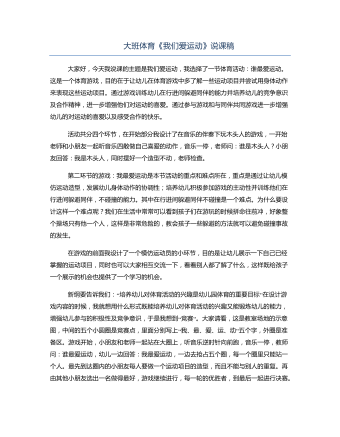
大班体育《我们爱运动》说课稿
活动共分四个环节,在开始部分我设计了在音乐的伴奏下玩木头人的游戏,一开始老师和小朋友一起听音乐四散做自己喜爱的动作,音乐一停,老师问:谁是木头人?小朋友回答:我是木头人,同时摆好一个造型不动,老师检查。第二环节的游戏:我最爱运动是本节活动的重点和难点所在,重点是通过让幼儿模仿运动造型,发展幼儿身体动作的协调性;培养幼儿积极参加游戏的主动性并训练他们在行进间躲避同伴,不碰撞的能力。其中在行进间躲避同伴不碰撞是一个难点。为什么要设计这样一个难点呢?我们在生活中常常可以看到孩子们在游玩的时候拼命往前冲,好象整个操场只有他一个人,这样是非常危险的,教会孩子一些躲避的方法就可以避免碰撞事故的发生。在游戏的前面我设计了一个模仿运动员的小环节,目的是让幼儿展示一下自己已经掌握的运动项目,同时也可以大家相互交流一下,看看别人都了解了什么,这样既给孩子一个展示的机会也提供了一个学习的机会。新纲要告诉我们:“培养幼儿对体育活动的兴趣是幼儿园体育的重要目标”在设计游戏内容的时候,我就想用什么形式既能培养幼儿对体育活动的兴趣又能锻炼幼儿的能力,增强幼儿参与的积极性及竞争意识,于是我想到“竞赛”。大家请看,这是教室场地的示意图,中间的五个小圆圈是竞赛点,里面分别写上“我、最、爱、运、动”五个字,外圈是准备区。游戏开始,小朋友和老师一起站在大圈上,听音乐逆时针向前跑,音乐一停,教师问:谁最爱运动,幼儿一边回答:我最爱运动,一边去抢占五个圈,每一个圈里只能站一个人。最先到达圈内的小朋友每人要做一个运动项目的造型,而且不能与别人的重复。再由其他小朋友选出一名做得最好,游戏继续进行,每一轮的优胜者,到最后一起进行决赛。
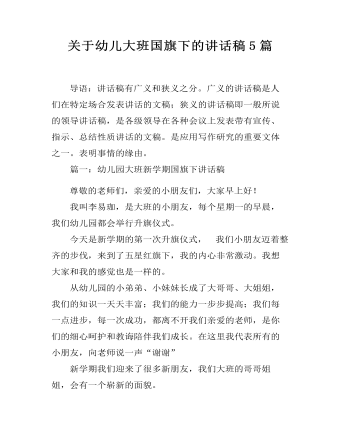
关于幼儿大班国旗下的讲话稿5篇
导语:讲话稿有广义和狭义之分。广义的讲话稿是人们在特定场合发表讲话的文稿;狭义的讲话稿即一般所说的领导讲话稿,是各级领导在各种会议上发表带有宣传、指示、总结性质讲话的文稿。是应用写作研究的重要文体之一。表明事情的缘由。篇一:幼儿园大班新学期国旗下讲话稿 尊敬的老师们,亲爱的小朋友们,大家早上好!我叫李易珈,是大班的小朋友,每个星期一的早晨,我们幼儿园都会举行升旗仪式。今天是新学期的第一次升旗仪式, 我们小朋友迈着整齐的步伐,来到了五星红旗下,我的内心非常激动。我想大家和我的感觉也是一样的。从幼儿园的小弟弟、小妹妹长成了大哥哥、大姐姐,我们的知识一天天丰富;我们的能力一步步提高;我们每一点进步,每一次成功,都离不开我们亲爱的老师,是你们的细心呵护和教诲陪伴我们成长。在这里我代表所有的小朋友,向老师说一声“谢谢”新学期我们迎来了很多新朋友,我们大班的哥哥姐姐,会有一个崭新的面貌。

人教版新目标初中英语八年级下册If you go to the party, you’ll have a great time说课稿9篇
二、说教学目标:由于本单元的五个话题都涉及到了不同的条件下所产生的各种结果。所以我确定的本课时的教学目标是:通过谈论图片和身边常见的话题,学会if引导的条件状语从句的用法。即用if条件状语从句作出假设,用will来谈论结果。三、说教学重点:一方面,由于本单元的话题是谈论结果,那么在不同的情境下其结果也会不一样,所以根据不同的情境来推测并谈论各种结果是个重点。另一方面,因为学生没有一个好的语言氛围,所以我侧重于听力和口语的培养,多创设情境能让学生发挥想象,以此激发他们的学习兴趣,。四、说教学难点学生容易记住主句用一般将来时态,从句用一般现在时态,但在判断主句、从句方面容易混淆,因此,我将正确使用主句从句的时态定为本课时的难点。
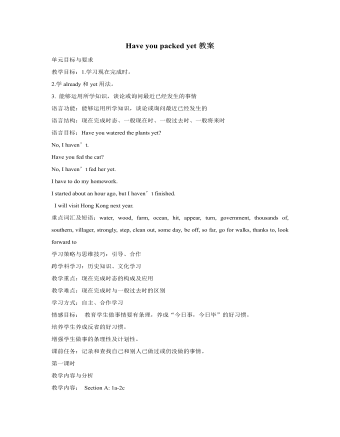
人教版新目标初中英语九年级下册Have you packed yet教案
教学目标:1.学习现在完成时。2.学already和yet用法。3. 能够运用所学知识,谈论或询问最近已经发生的事情语言功能:能够运用所学知识,谈论或询问最近已经发生的语言结构:现在完成时态、一般现在时、一般过去时、一般将来时语言目标:Have you watered the plants yet?No, I haven’t.Have you fed the cat?No, I haven’t fed her yet.I have to do my homework. I started about an hour ago, but I haven’t finished. I will visit Hong Kong next year.重点词汇及短语:water, wood, farm, ocean, hit, appear, turn, government, thousands of, southern, villager, strongly, step, clean out, some day, be off, so far, go for walks, thanks to, look forward to学习策略与思维技巧:引导、合作跨学科学习:历史知识、文化学习教学重点:现在完成时态的构成及应用教学难点:现在完成时与一般过去时的区别 学习方式:自主、合作学习 情感目标: 教育学生做事情要有条理,养成“今日事,今日毕”的好习惯。培养学生养成反省的好习惯。增强学生做事的条理性及计划性。课前任务:记录和查找自己和别人已做过或仍没做的事情。
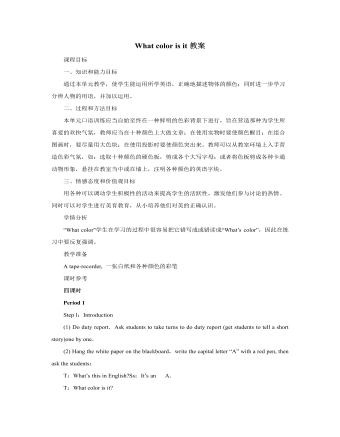
人教版新目标初中英语七年级上册What color is it教案
一、知识和能力目标通过本单元教学,使学生能运用所学英语,正确地描述物体的颜色;同时进一步学习分辨人物的用语,并加以运用。二、过程和方法目标本单元口语训练应当自始至终在一种鲜明的色彩背景下进行,旨在营造那种为学生所喜爱的欢快气氛,教师应当在十种颜色上大做文章;在使用实物时要使颜色醒目;在组合图画时,要尽量用大色块;在使用投影时要使颜色突出来。教师可以从教室环境上入手营造色彩气氛,如:选取十种颜色的硬色板,剪成各个大写字母;或者将色板剪成各种卡通动物形象,悬挂在教室当中或在墙上,注明各种颜色的英语字块。三、情感态度和价值观目标用各种可以调动学生积极性的活动来提高学生的活跃性,激发他们参与讨论的热情。同时可以对学生进行美育教育,从小培养他们对美的正确认识。
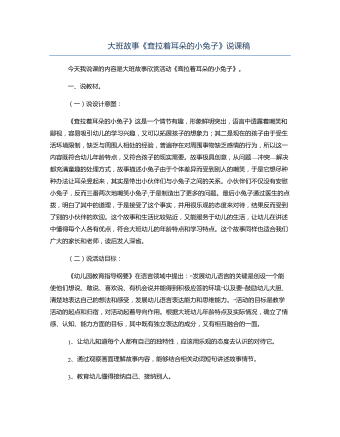
大班故事《耷拉着耳朵的小兔子》说课稿
《耷拉着耳朵的小兔子》这是一个情节有趣,形象鲜明突出,语言中透露着嘲笑和鄙视,容易吸引幼儿的学习兴趣,又可以拓展孩子的想象力;其二是现在的孩子由于受生活环境限制,缺乏与周围人相处的经验,普遍存在对周围事物缺乏感情的行为,所以这一内容既符合幼儿年龄特点,又符合孩子的现实需要。故事极具创意,从问题—冲突—解决都充满童趣的处理方式,故事描述小兔子由于个体差异而受到别人的嘲笑,于是它想尽种种办法让耳朵竖起来,其实是带出小伙伴们与小兔子之间的关系。小伙伴们不仅没有安慰小兔子,反而三番两次地嘲笑小兔子,于是制造出了更多的问题。最后小兔子通过医生的点拨,明白了其中的道理,于是接受了这个事实,并用很乐观的态度来对待,结果反而受到了别的小伙伴的欢迎。这个故事和生活比较贴近,又能服务于幼儿的生活,让幼儿在讲述中懂得每个人各有优点,符合大班幼儿的年龄特点和学习特点。这个故事同样也适合我们广大的家长和老师,读后发人深省。
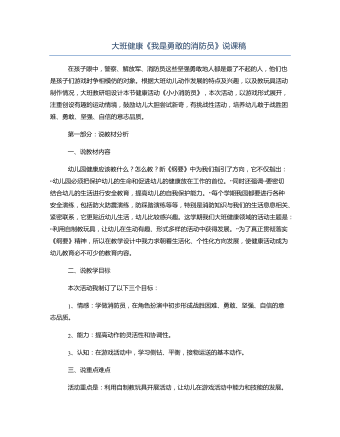
大班健康《我是勇敢的消防员》说课稿
幼儿园健康应该教什么?怎么教?新《纲要》中为我们指引了方向,它不仅指出:“幼儿园必须把保护幼儿的生命和促进幼儿的健康放在工作的首位。”同时还强调“要密切结合幼儿的生活进行安全教育,提高幼儿的自我保护能力。”每个学期我园都要进行各种安全演练,包括防火防震演练,防踩踏演练等等,特别是消防知识与我们的生活息息相关、紧密联系,它更贴近幼儿生活,幼儿比较感兴趣。这学期我们大班健康领域的活动主题是:“利用自制教玩具,让幼儿在生动有趣、形式多样的活动中获得发展。”为了真正贯彻落实《纲要》精神,所以在教学设计中我力求朝着生活化、个性化方向发展,使健康活动成为幼儿教育必不可少的教育内容。
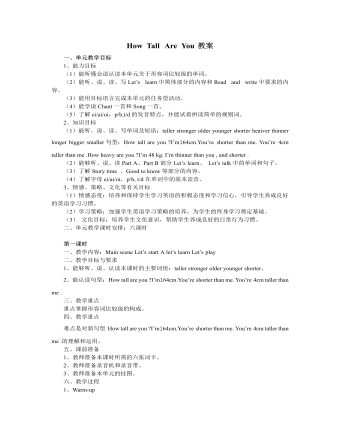
人教版新课标PEP小学英语六年级下册How Tall Are You教案
(1)呈现猴子图片,初步接触知识.教师在发指令时,加入 Touch your tail.当学生觉得茫然时,老师趁机出示课件(一只猴子)Look,We have no tails,but the monkey has.Look at the monkey,How long is the tail?在课件上呈现数据38cm.学生回答:Its tail is38cm long.根据教材内容教师提问:How tall is the monkey?学生:It’s 40cm tall.老师自己引出only一词,注意这个词的发音.多媒体再出示两只猴子的图片,一只黄色,一只棕色,让学生加以比较.教师问:Which monkey do you like?The yellow one or the brown one?【设计思路】 学生在回答这些问题时,也同时在复习前两课时所学内容,起到知识循环的作用.(2)猜一猜游戏:它们有多高?让学生猜一猜这两只猴子的身高.注意提示学生用上I think….这一句型,表示自己的猜测.在这里也可安排一个竞赛,看谁能猜中正确数据,教师让一些学生猜后出示数据.【设计思路】 学生对有悬念的东西都特别感兴趣,在此不仅练习了两位数的读法,又满足了学生的好胜心理.

人教版新目标初中英语八年级下册Have you ever been to an amusement park教案
(1)Have you ever been to …? Yes, I have. / Yes, I have ever been to …No, I haven’t. / No, I have never been to …(2)When did you go there? I went there last year. (3)I have never been to a water park. Neither have I. I have ever been to an amusement park. So have I. (4)How long have you been studying English? I’ve been studying English since nine o’clock. I’ve been studying English since I came back home. I’ve been studying English for five hours. (5)What’s that? It’s an amusement park in Japan. I’ve never been to an amusement park like it before. It’s fun to learn another language. Let’s go tonight. Isn’t this great?space museum, amusement park, water park, South America, Peru, Holland, European culture, tour guide, flight attendant, musical instrument, more than, be from, get to, take lessons, neither, discover, graduate, change

人教版新目标初中英语七年级上册Can you play the guitar教案
本单元主要是学习情态动词can的肯定句、否定句、一般疑问句,肯定与否定回答,以及特殊疑问句的构成和用法;复习what弓!导的特殊疑问句。本单元主要围绕“加人俱乐部,谈论自己的能力”这一话题,设计了三个任务型活动:任务一是:自己的才艺表演,学习情态动词can的用法;任务二是:自己建立俱乐部,运用情态动词can谈论自己在某一方面的能力、喜好和意愿;任务三是:我能成功,主要是复习巩固谈论各自的爱好和特长的方法。单元知识系统(树)Can you/he/she/you dance? 一Yes,I/he/she/we can./No,I/he/she/we can’t.Can Bill play the guitar?一Yes,he can,but he can’t sing.单元总体目标通过学习情态动词can的用法,使学生能够表达自己在某一方面所具备的才能;能够谈论自己的喜好与意愿;能够为自己成立的各种俱乐部制作海报;会写招聘广告。单元重难点一览重点 难点I.复习词汇:can,play,want2.词汇:guitar, dance, swim,sing, chess, speak, drum,trumpet,violin,play the guitar3.句型:Can you/he/she/you dance?Yes,I/he/she/we can./No,I/he/she/we can’t.Can Bill play the guitar?

人教版新目标初中英语七年级下册Where did you go on vacation教案
句型: Where did you go on vacation? I went to summer camp.Did she go to Central Park?Yes,she did.No, she didn’t语法:一般过去时特殊疑问句、一般疑问句及肯、否定回答。课时安排4课时第一课时:Section A:la,1b,lc,2a,2b,2c 第二课时:Section A:3a,3b,4第三课时:Section B:1,2a,2b,2c第四课时:Section B:3a,3b,3c,4 and Self Check第一课时教学目标掌握描写假期生活的形容词。假期里自己所做事情的简单表达。谈论假期做的事情及当时情况。谈论假期时旅游的天气,旅游者以及食物等。教学过程一、导入播放一首英文歌曲:Let’s travel 说明:通过让学生听节奏欢快迪斯尼英语歌曲Let’s travel.引入本节课谈论的话题vacation and travel. 让歌曲使学生的思维活跃,增强课堂气氛,激发学生提高学习英语的兴趣。T:How is the trip ?Ss : It’s pretty good/ happy/exciting /relaxing/busy/dangerous/ fantastic说明:这个问题是为了操练形容词。建议让多个Ss作答。鼓励他们用不同的形容词。上述个别形容词本应在第二课时中出现,但可以在warming-up中第一次非正式出现。这些形容词也可在老师的评价语中适时出现,以加深学生对词汇的印象。

人教版新目标初中英语八年级上册Can you come to my party教案3篇
Step 3 (3b)First, tell the students when we talk about our future plans, we often use: I’m+verb+ing When we talk about what we must do, we use have to. Ask the students to fill in the blanks in 3b. The answers are: shopping, go to see, a test, I’m going, my family. Step 4 (3c)Let the students write an e-mail message to a friend. Say why you can’t visit next. Before the exercise, ask the students to give some possible answers and write them on the blackboard. So the students will feel easy to finish the writing exercise. After they finish it, Let them to correct it in groups first. Each group chooses theirs best one to read in front of the whole class. Step 5 ( planning a party )First read the conversation in the box together. Then ask the students to turn to page 88.Write down everything you have to do next week. Write in all the things you have to do . Ask the students to look at the list. Ask them “What day are you free?” This is when you can have your party. Step 6 (Self check 1 )Let the students to fill in the blanks with the words given. Change the forms of the words if possible. Then make their own sentences. The answers are: visit, playing, have to, study, comeStep 7 (Self check 2)Imagine you are Marie. Read the information and look at your schedule. Write replies to the invitation.

人教版新目标初中英语八年级上册Could you please clean your room教案3篇
一、 教学内容Section A 1a----1c二、 教学目标1.学习词汇do the dishes, make the bed, take out the trash, fold the clothes, do the laundry, sweep the floor, clean the living room.2.句型 Could you please clean your room? Yes, sure.三、 教学准备 学生预习本单元所有的词汇多媒体课件 活动表 奖品四、 教学过程Pre-task1. Warming upEnjoy ourselves. Watch cartoon Cinderella. 看动画片段《灰姑娘》导如入本课话题和新词汇“chores”美丽善良的鬼姑娘因继母的嫉妒,每天得做所有的家务。片段的主题使学生联想到本课的话题。2. learn new words and phrasesLook! What is she / he dong? 看图学习动词词组do chores, do the dishes, make the bed, take out the trash, fold the clothes, do the laundry, clean the living room.3. Guessing game.What is she doing ? 4. Pair work. 1a, Do you do these things at home? Write “Y” for “yes” and “N” for “no”.5. Listening . 1b , Peter’s chores or Mom’s chores?理解目标语Could you please clean your room? Yes, sure.Write “M” for Mom’s chores, “P” for Peter’s chores in the chart.6. PairworkLook at the picture,Ask your partner to do the chores that you see. 7. Interview Who is the most able at home? 1) What chores do you do at home? How often do you do the chores? Work in four, interview each of the students in the group, fill in the chart.

人教版新目标初中英语八年级下册How long have you been collecting shells教案2篇
Step Ⅱ Show the new words on the screen and teach the new words. Read the new words to students and ask them to repeat.Step Ⅲ 3aThis activity introduces new vocabulary and provides reading practice using the target language.In this activity first look at the four pictures.T: What can you see in the pictures?Ss: Four snow globes.T: Right. There are four snow globes in the pictures. And what are they?Ss: They are a monster, two polar bears, two penguins and a birthday cake.Write these words on the blackboard: snow globe; monster; polar bear; penguin and birthday cake. Read them to the class and ask students to repeat each one. Make sure students understand each word.Use a computer to show the E-mail message on the screen and read the message to students.Get students to read the e-mail on their own, and then draw lines connecting each snow globe and its description.Correct the answers.AnswersA line should connect each snow globe picture with the words that describe it in the letter.Step Ⅳ 3bThis activity provides writing practice using the target language.First review Activity 2a on Page 47.Then ask students to complete the message according to Activity 2a.Some partial sentences are given to students. Write about one person's collection.When students work, walk around the room checking the progress and offering help as needed.When they finish, ask some students to read their messages to the class.

人教版新目标初中英语八年级下册Why don’t you get her a scarf教案
教师带领学生复习有关描述宠物的词汇,采用教师提问学生回答的方进行。如:T:What animals do you think would be good pets?What animals do you think would be bad pets?What do you think are good animals for a six-year-old child?然后学生进行 pairwork 练习。Task two: 师生互动,学习探究 1、播放3a部分的录音,引导学生一边听录音,一边跟读。2、通过听录音学生回答以下问题:Why do you think pot-bellied pigs are popular?What are the advantages and disadvantages of keeping such a pet?教师对学生的回答进行及时点评。3.学习范文,学习重点短语,为下步的模仿写作提供语言素材。T :1. )Have you ever kept a pig as a pet?Do you like pigs? St.:No.…Why don’t you like to keep a pig? St: No.They’re too dirty and lazy(Do you know in some foreign countries like Hollyland, Australia,pigs are the most popular pet.there’s a kind of pig.(图)it has an interesting name? it ‘s called a pot-bellied pig.) Now,let’s learn an article about this kind of interesting pet.2.)play the tapeSt.:Listen and repeat3.)show some Qs on computer(本子St.: read silently,then answerthe Qs(本子)4.)Ask ss. Close book and retell this passage.(what is a pot-bellied pig? Is it a good or bad pet? ) St.: retell it to each other“A pot –bellied pig is a popular pet now…”5.read the article together.St.:.practice reading

人教版新目标初中英语八年级下册Would you mind turning down the music教案
Step 4. Group work (4)1. Ask a pair of students to read the dialogue. Say, This activity provides speaking, listening and writing practice using the target language.2. Ask students to complete the work in groups.3. Check the answers with the whole class. 4. Explain some of the language points. Step 5. Word review (Self check 1)1. Ask students to read the words and the phrases given. 2. Fill in the blanks with proper forms of these words to complete the sentences. 3. Check the answers with the whole class. Homework:Do activity 2 on page 57 after class. Period 6Teaching aims: 1. Teach vocabulary words and the useful expressions. 2. Enable the students to learn etiquette in different culture. 3. Help the students learn how to behave politely in public places and in daily life. Teaching procedures:Step 1. RevisionHelp students to review the function of making requests through a free talk. Then lead them to the topic of etiquette. Explain the meaning of etiquette. Or, ask students to look it up in the dictionary. Step 2. Pre-reading (Section 1)1. Ask students to read the picture and make a list with their partner about how many rules of etiquette can be seen being broken.

人教版新目标初中英语九年级上册Where would you like to visit教案2篇
The First PeriodⅠ.Teaching Aims and DemandsKnowledge Objects(1) Key Vocabularytiring, educational, fascinating, thrilling, peaceful, exotic, trek, jungle, take it easy, explore, historic, site(2) Target LanguageWhere would you like to go on vacation?I’d like to trek through the jungle, because I like exciting vacations.2. Ability Objects(1)Train students to talk about places they would like to visit with the target language.(2)Train students to describe vacations with different adjectives.(3)Train students' listening skill.3. Moral Object,It′s more interesting to go on vacating somewhere instead of staying at home.Ⅱ. Teaching Key Points1. Key Vocabularytiring, educational, fascinating, thrilling, peaceful, exotic, trek, jungle, take it easy, explore, historic, site2. Target LanguageTalk about different places with the target language.Ⅲ. Teaching Difficult Points1. Describe vacations with different adjectives.2. Talk about different places with the target language.Ⅳ. Teaching Methods1. Teaching by illumination2. Teaching by doing chain drills3. Teaching by pairworkⅤ. Teaching Aids1. A tape recorder2. Some pictures of different places with famous views

人教版新目标初中英语九年级下册Could you please tell me where the restrooms are教案
Step Ⅰ RevisionCheck homework. Ask a few students to read the article in 3a.Then ask a few students to read their guides.Step Ⅱ Part 1Look at the words in the box. Ask a student to read them. Make sure the students understand the meaning of the words. You are to fill in the blanks with the words. In some cases, students may need to use another form of the word, for example adjusting for tense or subject/ verb agreement.Ask students to fill in the blanks on their own.Check the answers. Step ⅢPart 2Go through the instructions with the class.Look at the example with the students.Ask students what the answer would be.Ask a student to read the question and answer it.Excuse me, could you tell me where the bank is, please?The bank is across the street from the shopping malt.Get students to complete the work in pairs.Check the answers. Ask a few students to read their questions.Step Ⅳ Just for Fun!Ask all the students to read the conversation. Ask: What is funny about this cartoon? Help students to explain. A Martian is a person from the planet Mars.There is no such thing as Martian food on Earth, and the clerk looks silly because he is trying to think of where there is a Martian restaurant.Invite some pairs of students to present this conversation to the rest of the class.Step Ⅴ Summary and HomeworkIn this class, we’ve done much writing practice using the key vocabulary words and the target language presented in this unit. After class, please finish the questions in 2 in your exercise books. Then finish the exercises on pages 47~48 of the workbook as well.The Seventh Period Ⅰ Teaching Aims and Demands1. Knowledge Objects(1) Key Vocabularyimage, adventure, jealousy, hero, crime, journey, brave, no longer, show interest in, take it easy, become interested in, plain looks(2)Text:Grown-ups like cartoons, too.2. Ability Objects(1) Fast-reading to get a general idea of the text.(2) Careful-reading to get the detailed information in the text.

人教版新目标初中英语九年级下册You’re supposed to shake hands教案
教学目标:1. 掌握本单元一些重点词汇的写法和用法。2. 学会自如谈论餐桌礼仪。Step 1 RevisionAsk some students to retell the customs at the table in France in the passage in 3a.Step 2 Self checkPart 1. Fill in each bland with the correct word given. Students do the exercises by themselves at first. Then check the answers. Ask the students to comprehend the sentences and help them point out uses of some words, like “arrive (at / in) sw., spend time / money on sth , spend time / money (in) doing sth.”Part 2. Read about Fan Ling’s experience in a western restaurant. Understand the passage. Point out some key points in the passage.1. be / get used to doing sth. 习惯做某事2. begin with = start with 以….开头3. crowd v. 挤满,塞满 the crowd 人群 crowded adj. 拥挤的Then students discuss about how she would solve her problem. Ask some to share their stories with others.Part 3. Complete the crossword by looking at the sentences on the left. Then check the answers.
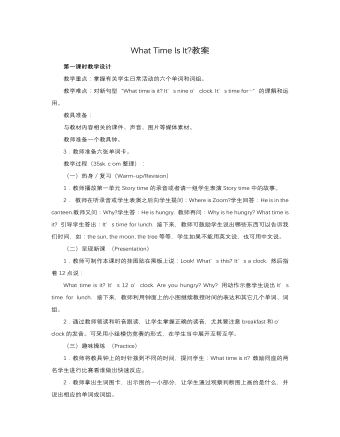
人教版新课标PEP小学英语四年级下册What Time Is It教案
2. 看图片或课件,回答理解性问题,并通过情景、动作等帮助学生理解hurry, ready 和oops的意义,可适当进行造句练习加以巩固,并注意对两个句型:“It’s time for ...”和“It’s time to ...”加以比较。听录音,然后跟读、模仿。分角色朗读和分角色表演。(三)趣味操练 (Practice)1.调查:设计一个调查表,然后调查五名学生或教师的作息时间,在四人小组中进行交流。鼓励学生用新句型“It’s time to ...”来表述。2.Let’s check教师连续播放三次录音。第一遍让学生先听录音,第二遍勾出与录音内容相符的一项,第三遍检查并核对答案。教师引导学生自我评价。(四)扩展性活动(Add-activities)1.做本单元B部分Let’s talk的活动手册配套练习。2.将本课时对话读给同伴、朋友或家长听。3.用英语向好朋友介绍自己的作息时间表。